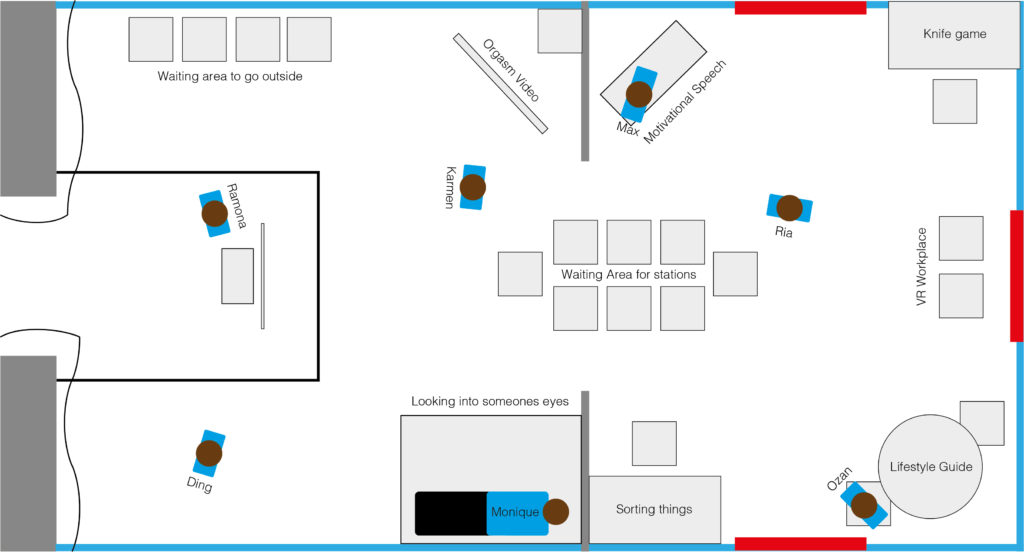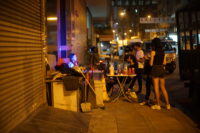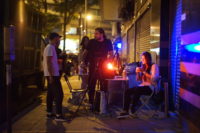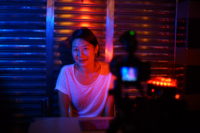Research
From the get-go we had a common understanding within the group that we all were interested in new technologies (in the broadest sense) and that we had the intention to realize a project which, at least for the first phase, had a extensive research approach. We started of with reading about random tech-related topics that we found interesting, mainly focused on Blockchain (a cryptography-based, decentralized database) and artificial intelligence (AI). We decided to write down interesting people, projects and institutions along the way and record the sources we’ve been engaged in.
We started off with researching on AI, deep learning and neural networks. When realising that it got too technical we tried to find applications of said technologies and looked into what kind of questions were evoked by it. Generative design and the question of whether an AI generated output could be considered art were some of the first topics we stumbled upon. Also the idea of an AI as a president or even higher, extraterrestrial powers brought interesting discussions of rationality versus emotions and the pros and cons of utilitarian systems. With AI the research also quickly went into the direction of the general role humans will play in the future and to a lesser extent,posthumanism. We also explored questions of biases of AI due to the lack of women and people of colour involved in the development and research in this matter.

Planning for XXX Gallery and settling on a topic
We had the event “Hou Gao Yeah!” at the gallery / club XXX coming up. We were told to use it as a testing ground for our final project. Our first idea was to use a program with face detection that judges people’s emotions based on their facial expression. We wanted to let the program detect the reactions of the audience during the other groups performances or while looking at their installations. Based on this information we would have created a critique of their works. Other ideas were playing with rules that were given by a place such as a club and with this exploring the topic of heterotopies.
In talking about aforementioned event at XXX we realised how our research was very broad and that it was time to focus onto a specific topic. We took a big sheet of paper and wrote AI on it. From there we connected different aspects that we found interesting. One was the topic of safety. How AI might soon surpass human intelligence and take away responsibilities. Another one was creativity. From this we could either go into the question of the capability of AI creating art or using AI as a tool for creative processes. With the term “bias” questions of gender and race in regard to AI came up. When talking about AI the word optimization often comes up. The future of work with AI on the rise seemed to be a emotional topic. Another compelling discourse was the meaning of being human and what would change if we had companion robots.
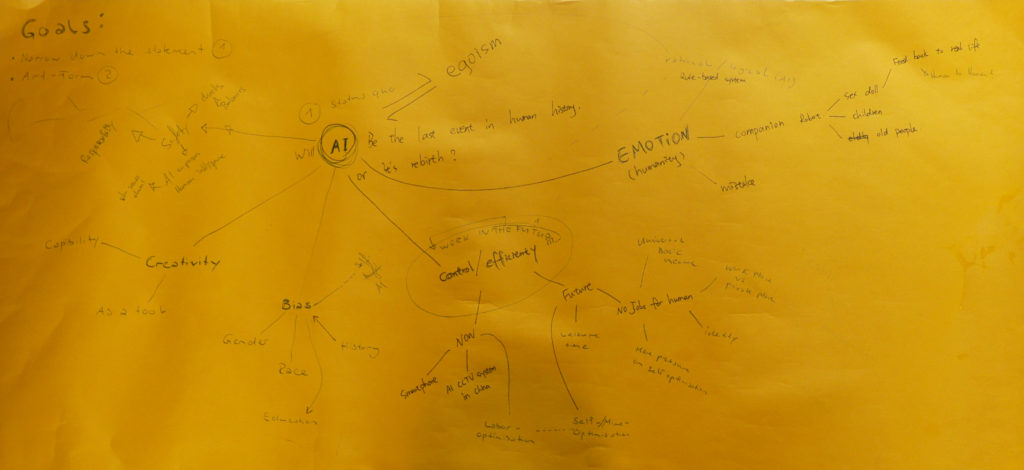
We decided to settle on the future of work, since it’s a topic everyone can relate to and there is a lot of interesting material to dive into. The futuristic setting also gave us a space to play with expectations and the entitlement to mold our own perspectives into the subject.
With this in mind we wanted to use the event at XXX as a way of gathering more informations. We wanted to find out how a range of various people who would visit this event related to automation and what it could possible do to the future of (their) work. Different ideas ranging from installations to interventions were developed before settling on simply interviewing people one by one.
At the same time we decided to use the name-list of people working in AI and ask for interviews to gather insights and opinions from experts. We came to the conclusion it would be crucial to have a wide span of opinions, going from laypersons to highly-qualified experts from very different disciplines.
XXX Gallery
At the event we set up a small table and two chairs (as well as a camera and a microphone) on the street across from the club. In exchange for an interview the participants would get a drink from our bar we had arranged next to the table. In order for the interviewees to loosen up, the idea was to create a casual, relaxed environment, similar to a situation one would experience in a bar or a pub. This is the questionnaire we used:
Topicality
Do you think you can be replaced by a robot?
Do you know anyone who got replaced by a robot?
Who of your friends would get replaced first?
Purpose of work
What gives you purpose in work?
How important is work to you?
Where would get you purpose if not work?
What would you do if you don’t have to work anymore or work less?
Value of human interaction / trust in robots
Do you think robots can do a better job than humans?
Would you rather:
…have your coffee made
… get a medical diagnosis from
…be taught classes
…get a massage
…cashiere to be
…want your legal assistance be
…operated by
a human or a robot? And why?
If you had a company would you use robots instead of humans?
Coexistence
Do you think we would live in a better world if we coexisted with robots?
Do you think it’s possible to coexist with robots?
Would you want to live in a world where everything stays the same?
Would you sleep with a robot?
It quickly became clear that even though the interviewees where no experts on the field, they all had a strong opinion on it. The reactions ranged from genuine excitement for the future to insecurity or even fear.
Planning for the final installation
While thinking about the form of our final installation, we could all see ourselves realizing a visual essay, since we had already gathered a lot of data on this topic.
While working on the questionnaire for the interviews with the experts, we thought about different concepts for the final presentation. We discussed the ideas of computer voices reading articles we found crucial to the topic, toy-robots stating random quotes of people interviewed at XXX when picked up, written questions directed to the audience in an open space, iPads mounted on sweeping robots that would play the interviews with experts or a booth where a robotic fortune teller would predict the possibility of your job being taken by a robot.

We settled on the idea of having two rooms, one where people could first get information and data on our research. Once they were acquainted with the context of our project, visitors would advance to the next room, where they would experience different thought experiments through using the information received previously and implementing it in the second room.

Expert interviews
We talked to different people we encountered during the process and had a Skype interview with Nadia Thalmann, professor at NTU Singapore and pioneer in social robots and an interview in person with Tomás Laurenzo, assistant professor at the School of Creative Media in Hong Kong. It was interesting to hear their perspective and sometimes very unexpected opinions. Nadia Thalmann for example completely debunked our idea of a universal basic income in stating that it was a very western mindset and not at all adaptable on other regions like Asia. But she was clearly very enthusiastic on the idea to be increasingly interacting with robots in the future. Thalmann had a very pragmatic perspective, saying she did not have any problem at all with interacting solely with robots at some point in the future.

Coming up with the final plan
After some discussions we decided to cut out the information based room and focus on the second one. We were appealed by one article which predicted that the recreational therapist would be the last job to go extinct. That led us to the hypothesis that automation will evidently destroy most jobs and people will be left with a lot more leisure time. Universal basic income will provide for all needs and society would be faced with new challenges and opportunities. What questions does this shift evoke? When digging into this question we discovered that eventually, the issues still revolved around identity, our place in society and to a greater extent, the purpose of life. Our aim was to create a leisure time therapy center, where people in the future would go if they needed treatment. In there they would be diagnosed and then would have to undergo therapy.
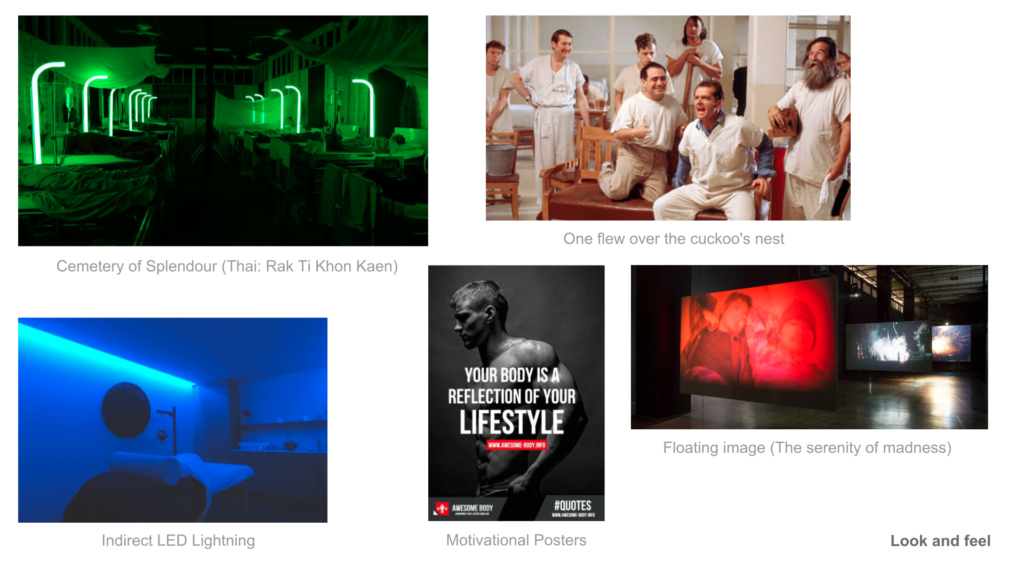
We worked out different scenarios and issues that could come up in our future lives like envy of robots, isolation, boredom, nostalgia, loss of excitement, numbness, insignificance, melancholy, fear of going offline, lack of structure, relationship issues and lethargy. These were all chosen based on the premise of basic income. We selected seven symptoms and created a treatment station within the therapy center for each.We also worked out a examination method in form of a questionnaire that would lead to the diagnosis.
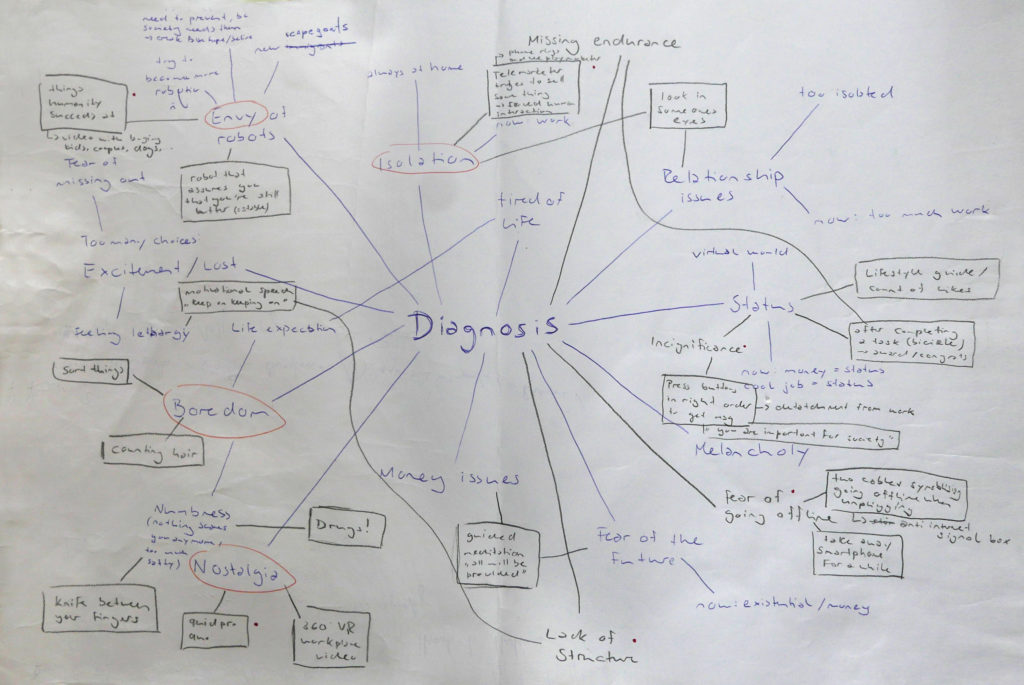
Set up
The room should feel as if it’s a place of the future. Accordingly, we tried to come up with a futuristic interface for where people would get their diagnosis. We used a special foil on plexiglas, where we projected a suspended talking head onto. This fictional floating face would ask preset questions. After each question the person being examined had to hover their hand over a distance sensor to show how much they related to the question. An arduino sent the data taken from the sensor and sent it to Processing on a computer. There every result got stored. Evidently, the program would analyse the results and play the video of diagnosis the most fitted.
The stations were designed with the same goal in mind. On top of that we wanted to create a feeling of uncanniness. For this we worked out a briefing for the performers working in our leisure time center.

